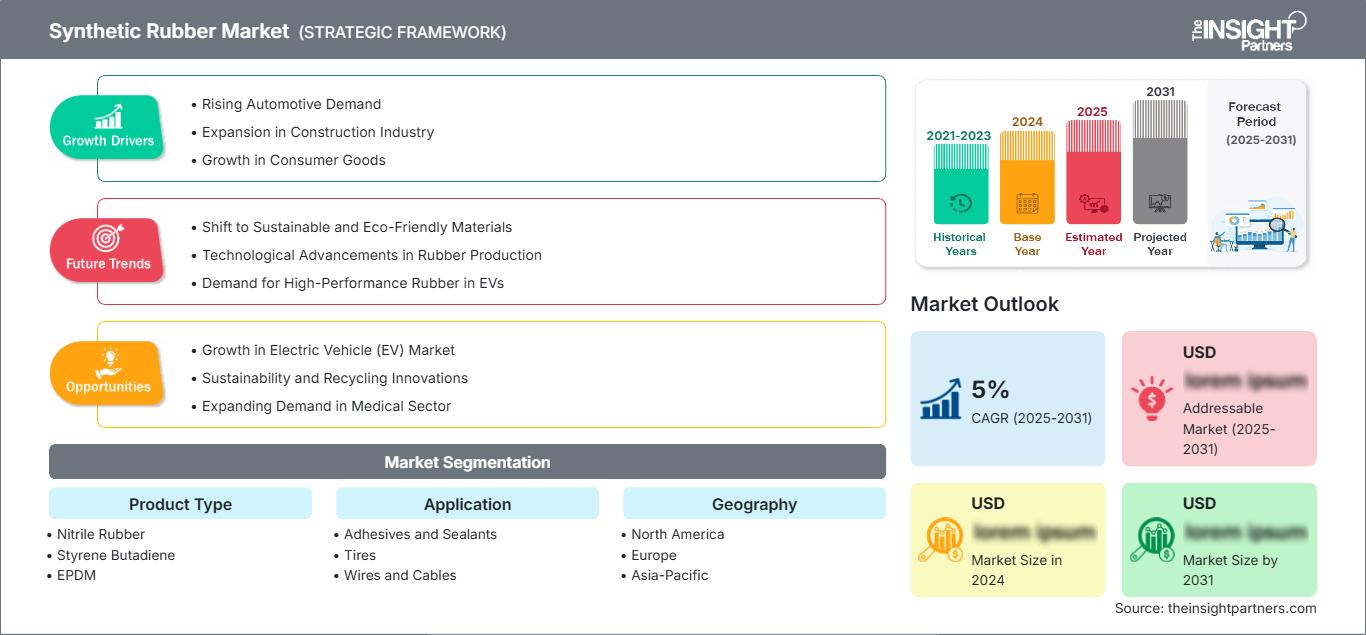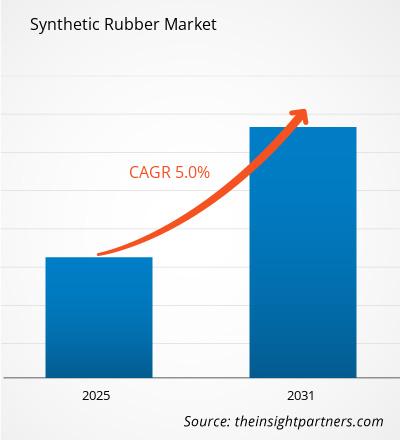预计到2031年,合成橡胶市场规模将达到452.3亿美元。预计2025年至2031年期间,该市场将以4.7%的复合年增长率增长。
本报告基于产品类型(丁腈橡胶、苯乙烯-丁二烯橡胶、三元乙丙橡胶、丁基橡胶、乙丙橡胶、氯丁橡胶等)进行分析。报告按应用领域(粘合剂和密封剂、轮胎、电线电缆、皮带和软管、添加剂等)进行细分。报告还按最终用户行业(汽车、航空航天、建筑、电气和电子、医疗保健、消费品等)进行细分。全球分析进一步细化到区域和主要国家层面。报告涵盖所有关键细分市场的全球、区域和国家层面的市场规模和预测。报告以美元为单位提供上述分析和细分市场的价值。报告提供主要市场参与者的市场地位关键统计数据,并分析市场趋势和机遇。
报告目的
The Insight Partners发布的《合成橡胶市场报告》旨在描述合成橡胶市场的现状和未来增长趋势,包括主要驱动因素、挑战和机遇。该报告将为各类商业利益相关者提供参考,例如:
- 技术提供商/制造商:了解不断变化的市场动态和潜在的增长机会,从而能够做出明智的战略决策。
- 投资者:对市场增长率、市场财务预测以及整个价值链中存在的机会进行全面的趋势分析。
- 监管机构:监管市场政策和执法活动,旨在最大限度地减少滥用行为,维护投资者信任和信心,维护市场的诚信和稳定。
合成橡胶市场细分产品类型
- 丁腈橡胶
- 苯乙烯丁二烯
- EPDM
- 丁基橡胶
- 乙烯丙烯二烯单体
- 氯丁橡胶
应用
- 粘合剂和密封剂
- 轮胎
- 电线电缆
- 皮带和软管
- 添加剂
您可以免费获得任何报告的定制服务,包括本报告的部分内容、国家/地区层面的分析、Excel 数据包,以及面向初创企业和高校的优惠折扣。
合成橡胶市场:战略洞察

-
获取本报告的主要市场趋势。这份免费样品将包含数据分析,内容涵盖市场趋势、估算和预测等。
合成橡胶市场增长驱动因素
- 汽车需求不断增长:汽车需求的增长,尤其是在新兴经济体,推动了合成橡胶市场的发展。合成橡胶广泛应用于轮胎、密封件和垫圈等领域,随着全球汽车产量的增长,对高质量、耐用橡胶部件的需求也随之增加,从而促进了市场增长。
-
建筑业扩张:建筑业报告范围
合成橡胶市场区域洞察
The Insight Partners 的分析师对预测期内影响合成橡胶市场的区域趋势和因素进行了详尽的阐述。本节还探讨了北美、欧洲、亚太、中东和非洲以及南美和中美洲等地区的合成橡胶市场细分和地域分布情况。
合成橡胶市场报告范围
欧洲通过申请- 粘合剂和密封剂
- 轮胎
- 电线电缆
- 皮带和软管
- 添加剂
- 英国
- 德国
- 法国
- 俄罗斯
- 意大利
- 欧洲其他地区
- 中国
- 印度
- 日本
- 澳大利亚
- 亚太其他地区
- 巴西
- 阿根廷
- 南美洲和中美洲其他地区
- 南非
- 沙特阿拉伯
- 阿联酋
- 中东和非洲其他地区
报告属性 细节 2024年市场规模 XX亿美元 到2031年市场规模 452.3亿美元 全球复合年增长率(2025-2031年) 4.7% 史料 2021-2023 预测期 2025-2031 涵盖的领域 按产品类型 - 丁腈橡胶
- 苯乙烯丁二烯
- EPDM
- 丁基橡胶
- 乙烯丙烯二烯单体
- 氯丁橡胶
覆盖地区和国家 北美 - 我们
- 加拿大
- 墨西哥
市场领导者和主要公司简介 - 中国石油化工集团公司
- 电卡株式会社
- 埃克森美孚公司
- 可乐丽株式会社
- LG化学
- 沙特基础工业公司
- Synthos SA
- TSRC
- UBE株式会社
合成橡胶市场参与者密度:了解其对业务动态的影响
合成橡胶市场正快速增长,这主要得益于终端用户需求的不断增长,而终端用户需求的增长又源于消费者偏好的转变、技术的进步以及消费者对产品优势认知的提高。随着需求的增长,企业不断拓展产品线、创新以满足消费者需求,并把握新兴趋势,这些都进一步推动了市场增长。

- 获取合成橡胶市场主要参与者概览
- 历史分析(2 年)、基准年、预测(7 年)及复合年增长率
- PEST和SWOT分析
- 市场规模、价值/数量 - 全球、区域、国家
- 行业和竞争格局
- Excel 数据集
近期报告
客户评价
购买理由
- 明智的决策
- 了解市场动态
- 竞争分析
- 客户洞察
- 市场预测
- 风险规避
- 战略规划
- 投资论证
- 识别新兴市场
- 优化营销策略
- 提升运营效率
- 顺应监管趋势






















 获取免费样品 - 合成橡胶市场
获取免费样品 - 合成橡胶市场